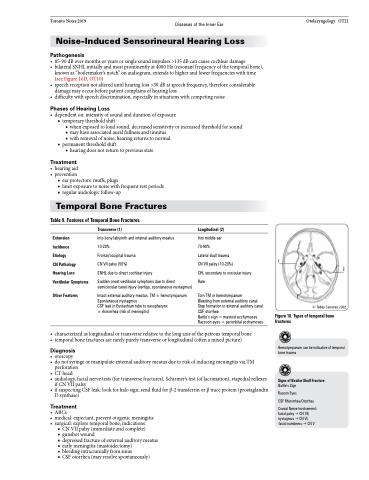Page 1007 - TNFlipTest
P. 1007
Toronto Notes 2019 Diseases of the Inner Ear Noise-Induced Sensorineural Hearing Loss
Pathogenesis
• 85-90dBovermonthsoryearsorsinglesoundimpulses>135dBcancausecochleardamage
• bilateralSNHLinitiallyandmostprominentlyat4000Hz(resonantfrequencyofthetemporalbone),
known as “boilermaker’s notch” on audiogram, extends to higher and lower frequencies with time
(see Figure 16D, OT10)
• speechreceptionnotaltereduntilhearingloss>30dBatspeechfrequency,thereforeconsiderable
damage may occur before patient complains of hearing loss
• difficultywithspeechdiscrimination,especiallyinsituationswithcompetingnoise
Phases of Hearing Loss
• dependenton:intensityofsoundanddurationofexposure ■ temporary threshold shift
◆ when exposed to loud sound, decreased sensitivity or increased threshold for sound ◆ may have associated aural fullness and tinnitus
◆ with removal of noise, hearing returns to normal
Otolaryngology OT21
■ permanent threshold shift
◆ hearing does not return to previous state
Treatment
• hearingaid • prevention
■ ear protectors: muffs, plugs
■ limit exposure to noise with frequent rest periods ■ regular audiologic follow-up
Temporal Bone Fractures
Table 9. Features of Temporal Bone Fractures
Extension
Incidence
Etiology
CN Pathology Hearing Loss Vestibular Symptoms
Other Features
Transverse (1)
Into bony labyrinth and internal auditory meatus 10-20%
Frontal/occipital trauma
CN VII palsy (50%)
SNHL due to direct cochlear injury
Sudden onset vestibular symptoms due to direct semicircular canal injury (vertigo, spontaneous nystagmus)
Intact external auditory meatus, TM ± hemotympanum Spontaneous nystagmus
CSF leak in Eustachian tube to nasopharynx
± rhinorrhea (risk of meningitis)
Longitudinal (2)
Into middle ear
70-90%
Lateral skull trauma
CN VII palsy (10-20%)
CHL secondary to ossicular injury Rare
Torn TM or hemotympanum
Bleeding from external auditory canal Step formation in external auditory canal CSF otorrhea
Battle’s sign = mastoid ecchymoses Raccoon eyes = periorbital ecchymoses
1
2
© Teddy Cameron 2002
• characterizedaslongitudinalortransverserelativetothelongaxisofthepetroustemporalbone • temporalbonefracturesarerarelypurelytransverseorlongitudinal(oftenamixedpicture)
Diagnosis
• otoscopy
• donotsyringeormanipulateexternalauditorymeatusduetoriskofinducingmeningitisviaTM
perforation
• CThead
• audiology,facialnervetests(fortransversefractures),Schirmer’stest(oflacrimation),stapedialreflexes
if CN VII palsy
• ifsuspectingCSFleak:lookforhalosign,sendfluidforβ-2transferrinorβtraceprotein(prostaglandin
D synthase)
Treatment
• ABCs
• medical:expectant,preventotogenicmeningitis • surgical:exploretemporalbone;indications:
■ CN VII palsy (immediate and complete)
■ gunshot wound
■ depressed fracture of external auditory meatus ■ early meningitis (mastoidectomy)
■ bleedingintracraniallyfromsinus
■ CSF otorrhea (may resolve spontaneously)
Figure 18. Types of temporal bone fractures
Hemotympanum can be indicative of temporal bone trauma
Signs of Basilar Skull Fracture
Battle’s Sign
Racoon Eyes
CSF Rhinorrhea/Otorrhea
Cranial Nerve Involvement: facial palsygCN VII, nystagmusgCN VI,
facial numbnessgCN V


